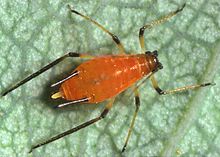
Back Plantluis Afrikaans من (حشرة) Arabic من (فصيله من الحشرات) ARZ Aphidoidea AST Mənənələr Azerbaijani Кеблә Bashkir Sausīs BAT-SMG Тлі Byelorussian Тлі BE-X-OLD Листни въшки Bulgarian
| Aphids Temporal range:
| |
|---|---|

| |
| Scientific classification | |
| Domain: | Eukaryota |
| Kingdom: | Animalia |
| Phylum: | Arthropoda |
| Class: | Insecta |
| Order: | Hemiptera |
| Suborder: | Sternorrhyncha |
| Infraorder: | Aphidomorpha |
| Superfamily: | Aphidoidea Geoffroy, 1762 |
| Families | |
| |
Aphids are small sap-sucking insects and members of the superfamily Aphidoidea. Common names include greenfly and blackfly,[a] although individuals within a species can vary widely in color. The group includes the fluffy white woolly aphids. A typical life cycle involves flightless females giving live birth to female nymphs—who may also be already pregnant, an adaptation scientists call telescoping generations—without the involvement of males. Maturing rapidly, females breed profusely so that the number of these insects multiplies quickly. Winged females may develop later in the season, allowing the insects to colonize new plants. In temperate regions, a phase of sexual reproduction occurs in the autumn, with the insects often overwintering as eggs.
The life cycle of some species involves an alternation between two species of host plants, for example between an annual crop and a woody plant. Some species feed on only one type of plant, while others are generalists, colonizing many plant groups. About 5,000 species of aphid have been described, all included in the family Aphididae. Around 400 of these are found on food and fiber crops, and many are serious pests of agriculture and forestry, as well as an annoyance for gardeners. So-called dairying ants have a mutualistic relationship with aphids, tending them for their honeydew and protecting them from predators.
Aphids are among the most destructive insect pests on cultivated plants in temperate regions. In addition to weakening the plant by sucking sap, they act as vectors for plant viruses and disfigure ornamental plants with deposits of honeydew and the subsequent growth of sooty moulds. Because of their ability to rapidly increase in numbers by asexual reproduction and telescopic development, they are a highly successful group of organisms from an ecological standpoint.[1]
Control of aphids is not easy. Insecticides do not always produce reliable results, given resistance to several classes of insecticide and the fact that aphids often feed on the undersides of leaves. On a garden scale, water jets and soap sprays are quite effective. Natural enemies include predatory ladybugs, hoverfly larvae, parasitic wasps, aphid midge larvae, crab spiders, lacewing larvae, and entomopathogenic fungi. An integrated pest management strategy using biological pest control can work, but is difficult to achieve except in enclosed environments such as greenhouses.
Cite error: There are <ref group=lower-alpha> tags or {{efn}} templates on this page, but the references will not show without a {{reflist|group=lower-alpha}} template or {{notelist}} template (see the help page).
- ^ Piper, Ross (2007). Extraordinary Animals: An Encyclopedia of Curious and Unusual Animals. Greenwood Press. pp. 6–9. ISBN 978-0-313-33922-6.